Sourdough Multigrain Bread
Sourdough Multigrain Bread is the perfect sandwich loaf. The long, slow rise makes a bread with soft texture, hearty flavor and it stays fresh for several days.
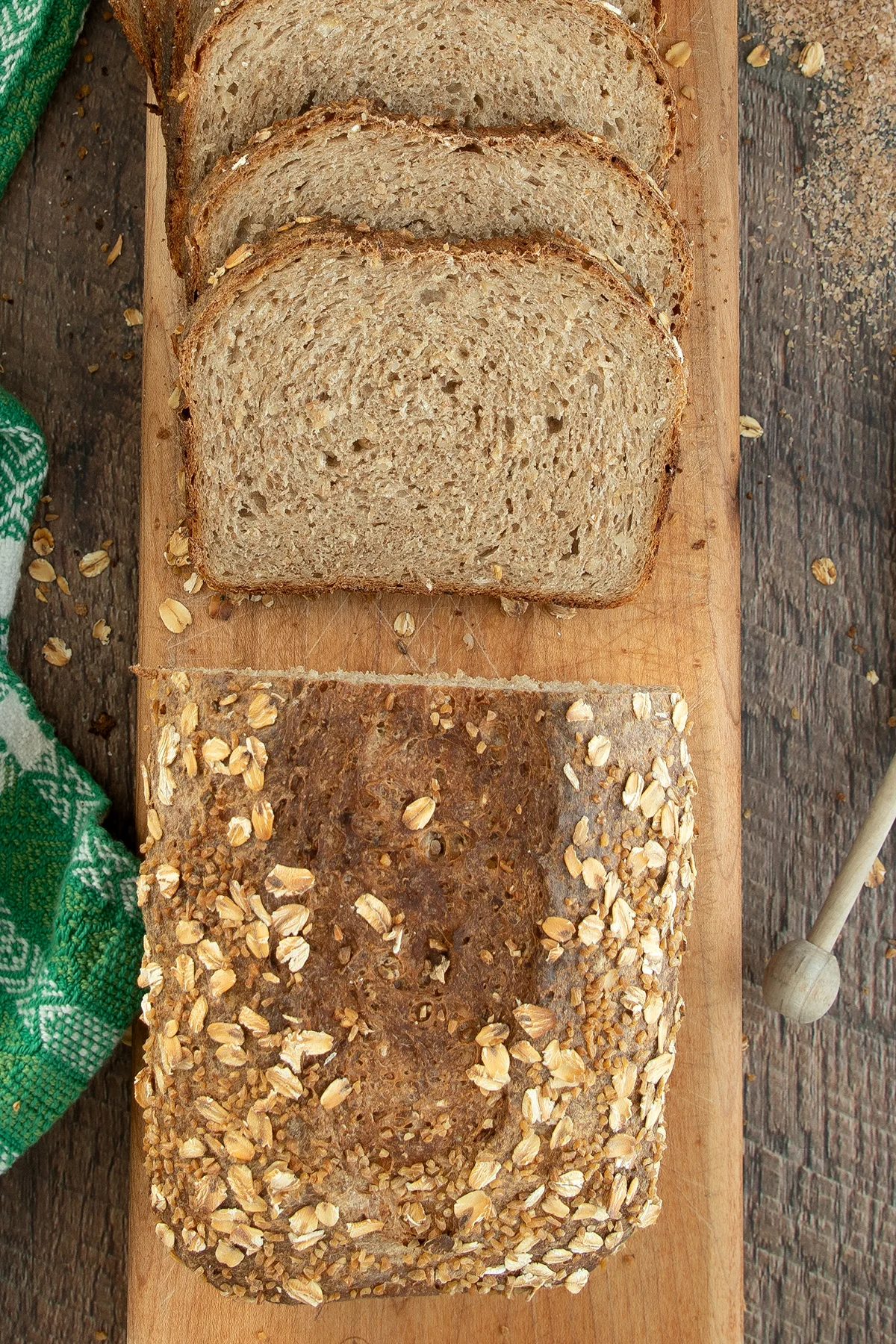
This recipe makes a loaf that is not only multigrain, it’s also mostly whole grain. There’s just enough bread flour in the recipe to develop the gluten.
Despite the heavier whole grains in the dough the gluten enables the bread to rise high in the oven.
The loaf comes out moist, chewy and not at all dense or heavy. It really is a great sandwich loaf.
If you don’t already have one, I can show you how to make a sourdough starter and how to feed a sourdough starter. While you’re growing your starter, you can make Multigrain Bread with commercial yeast.
You can mix and bake the bread all in one day or you can break the work into 2 days. (See the “tips” section below below for more information.)
Recipe Ingredients
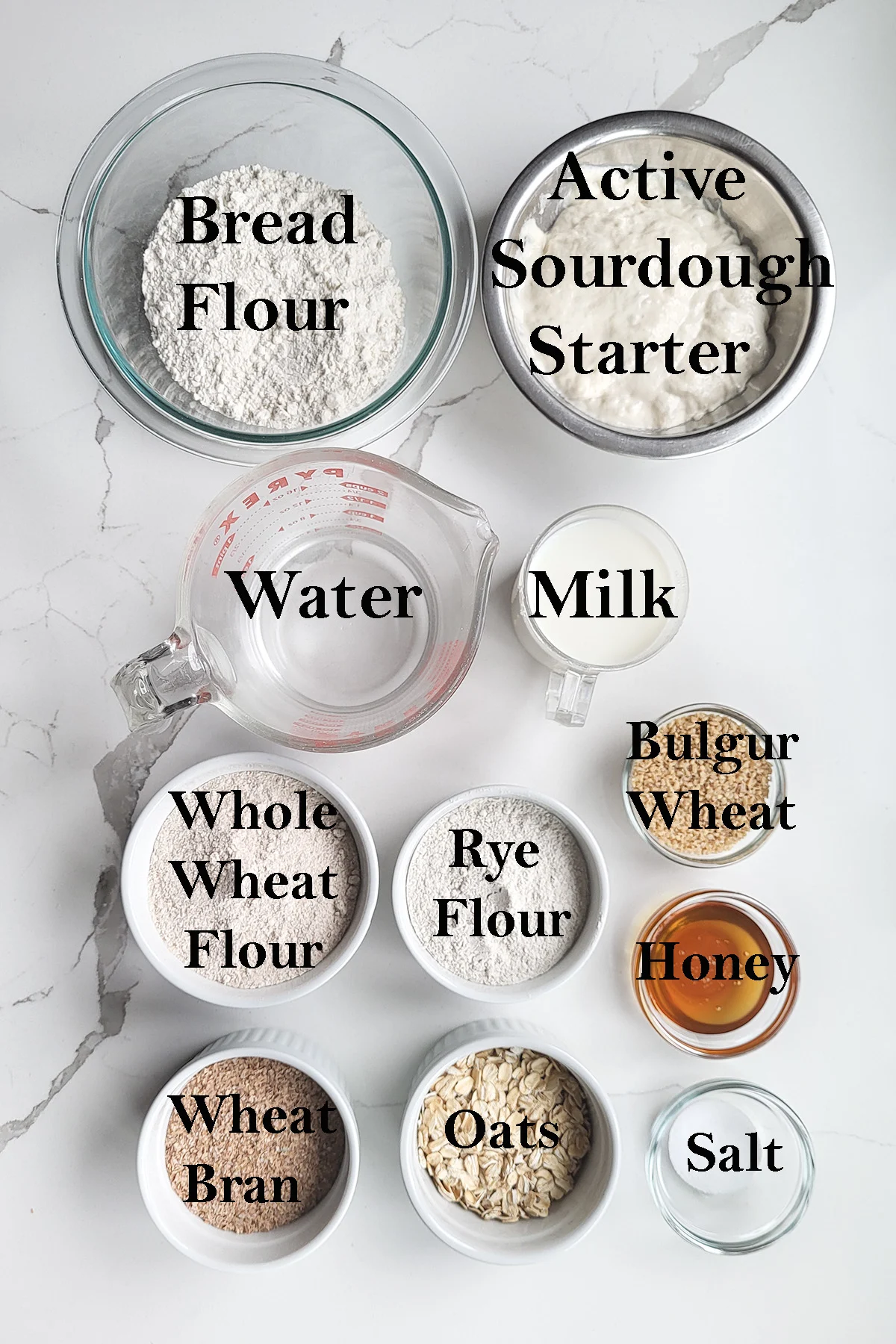
- Bread flour – Gives the bread structure.
- Active Sourdough Starter – 100% hydration. If your starter has a different hydration level you will need to adjust the amount of water or bread flour in the recipe.
- Water – Boiling water softens the bulgur wheat.
- Milk – Gives the bread a soft and rich texture.
- Bulgur wheat – Adds a chewy texture and hearty flavor to the bread.
- Whole wheat flour – With the bread flour, the whole wheat flour forms the structure of the bread.
- Rye flour – Use whole grain rye flour for the best flavor.
- Honey – For a touch of sweetness. Honey helps the bread stay moist for several days.
- Wheat bran – For healthy fiber and great texture.
- Old fashioned oats – Oats add flavor and texture to the bread.
- Salt – For flavor.
- Egg – To brush the loaf before baking.
How to make Sourdough Multigrain Bread
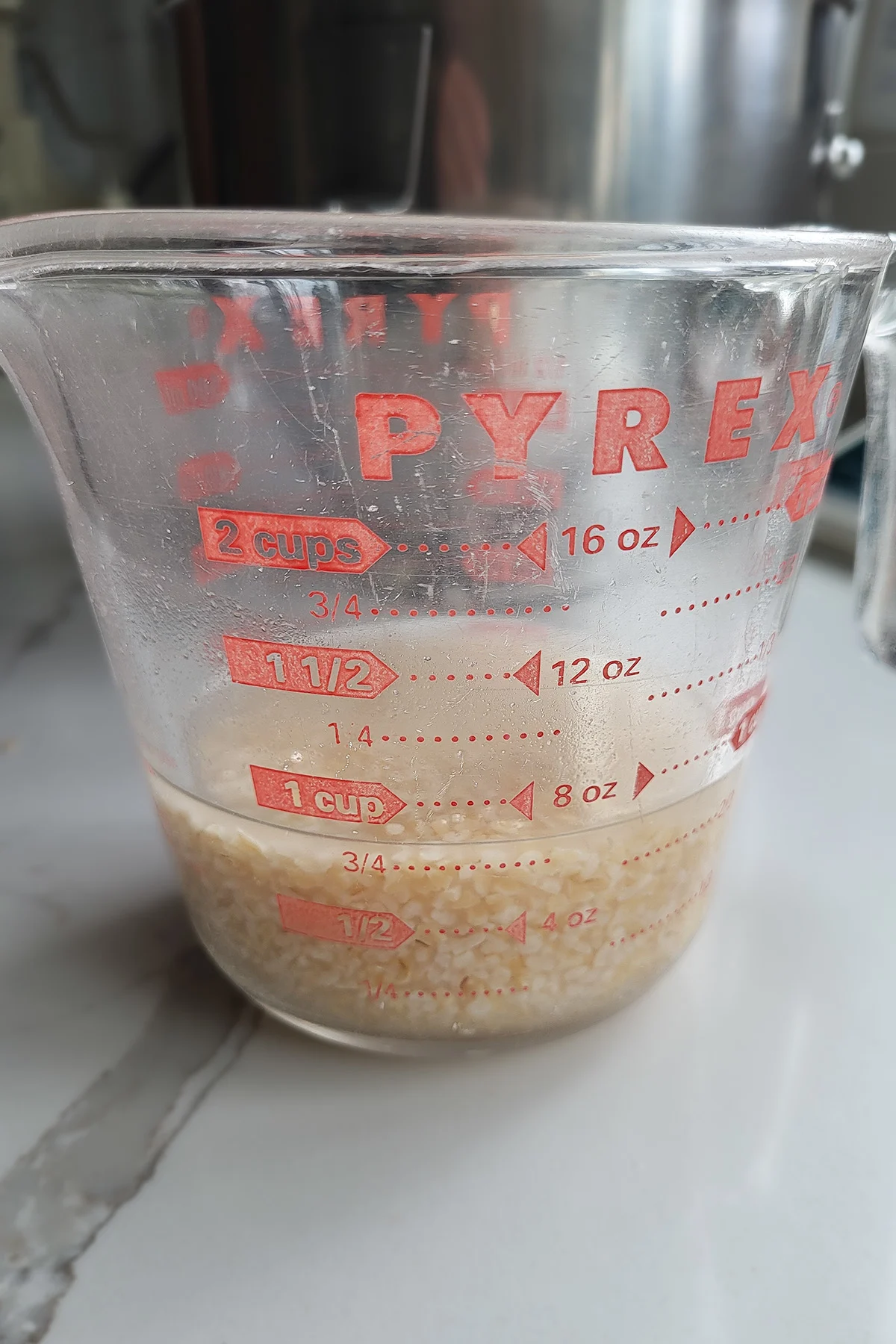
- Pour the boiling water over the bulgur wheat and set it aside. The bulgur wheat will soften and absorb most of the water.
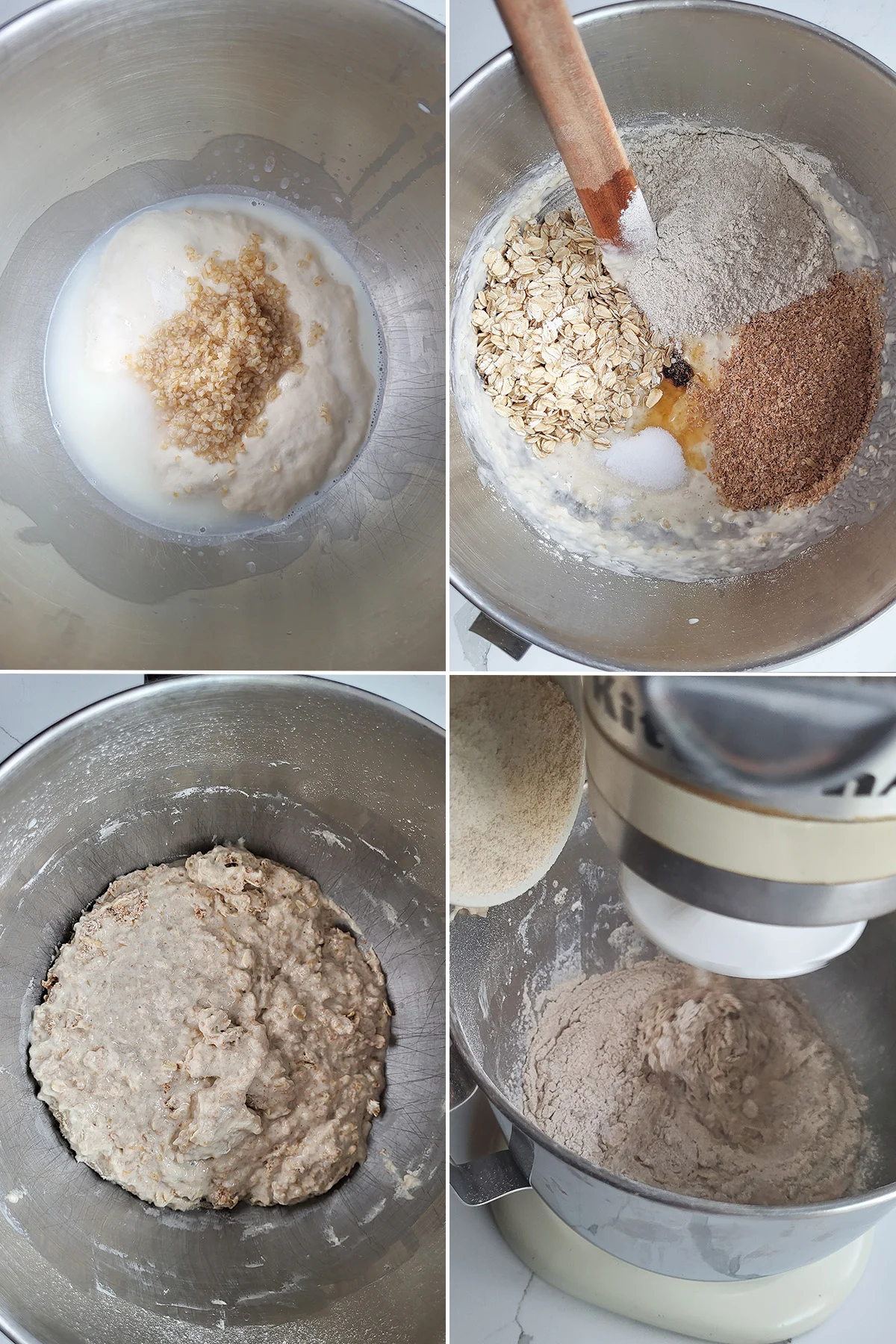
- Combine the bulgur wheat, milk, sourdough starter and the bread flour to form a smooth batter
- Add the honey, salt, oats, bran and rye flour.
- Mix until it forms a thick batter.
- Add the whole wheat flour. Knead for 5 minutes. The dough will stick to the sides of the bowl.
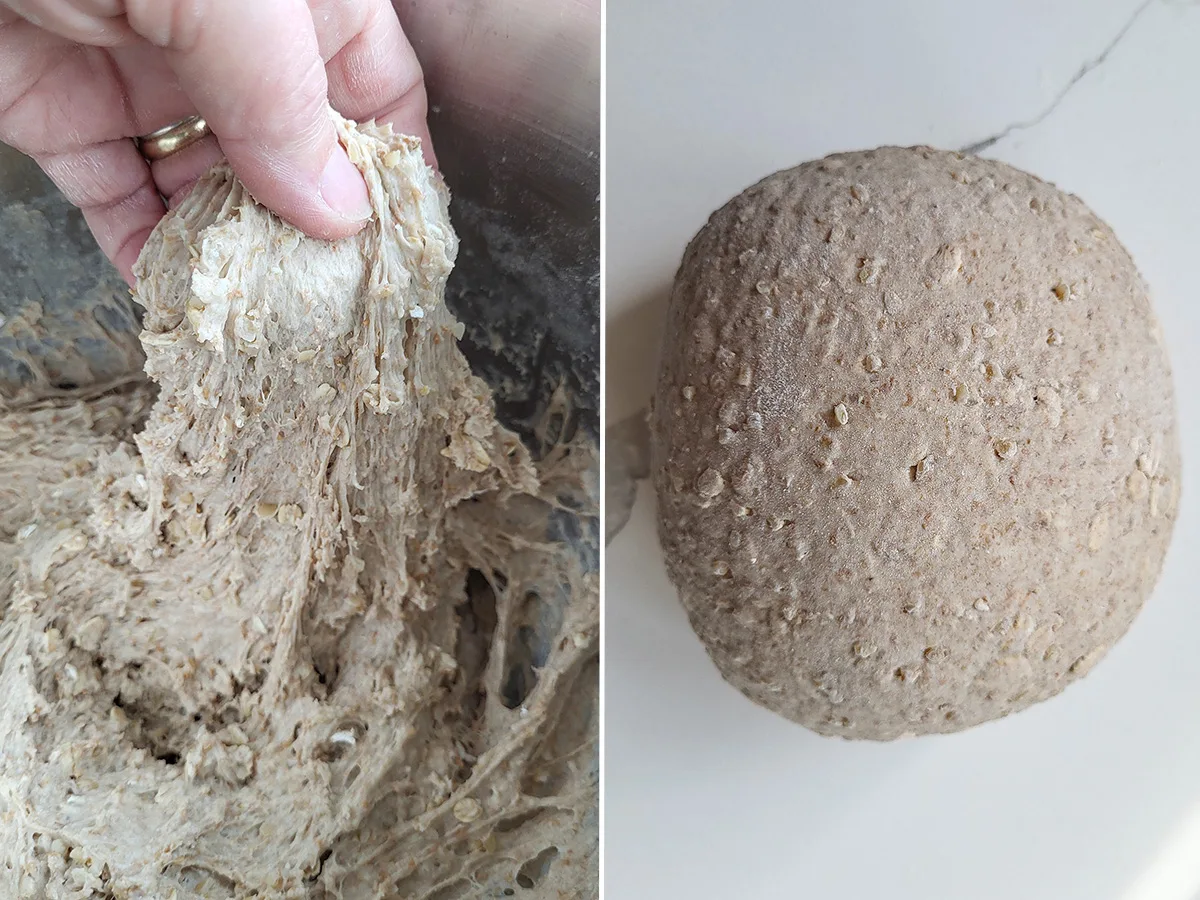
- The dough will look very sticky but it should have good stretch and elasticity.
- Turn the dough out onto a floured surface. Knead the dough a few times to form a ball.
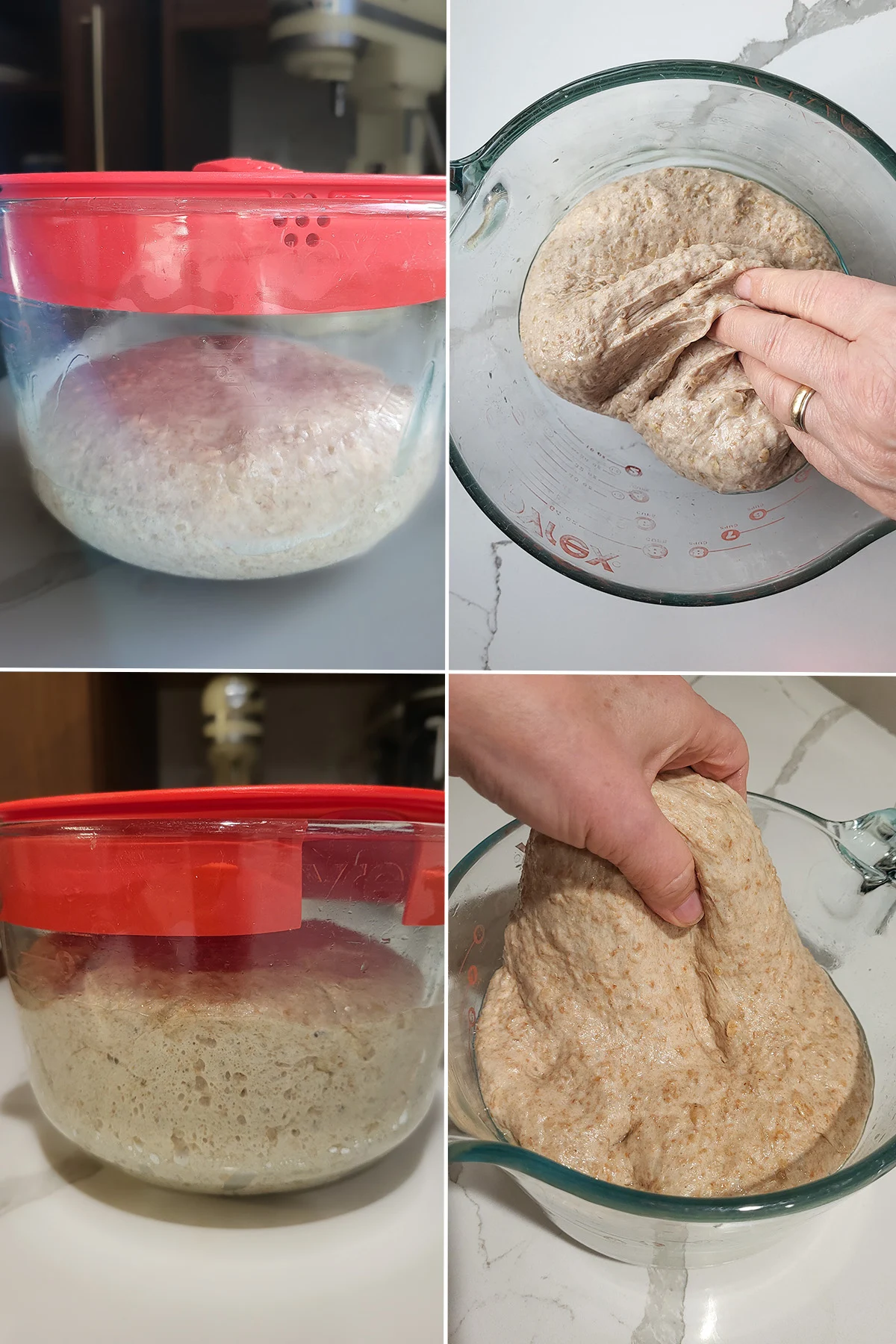
- Put the dough into an oiled bowl and set it aside to ferment for about 3 hours.
- Ever hour uncover the bowl, lift one side of the dough over into the middle of the dough. Repeat with the other three sides of the dough then flip the dough over.
- After 3 hours the dough should be aerated, supple and lively. Fold it one more time, cover and place the bowl into the refrigerator overnight (see “tips” section below if you’d like to bake the same day).
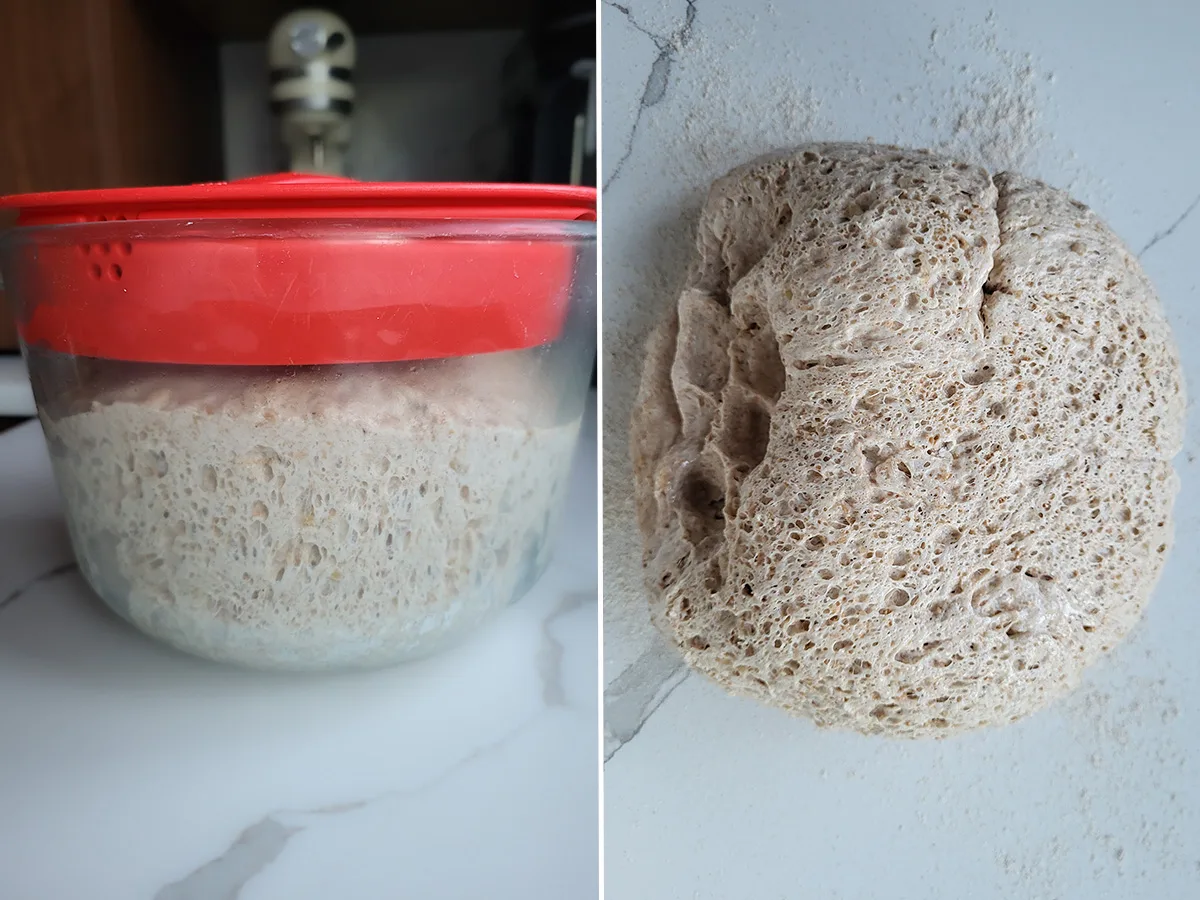
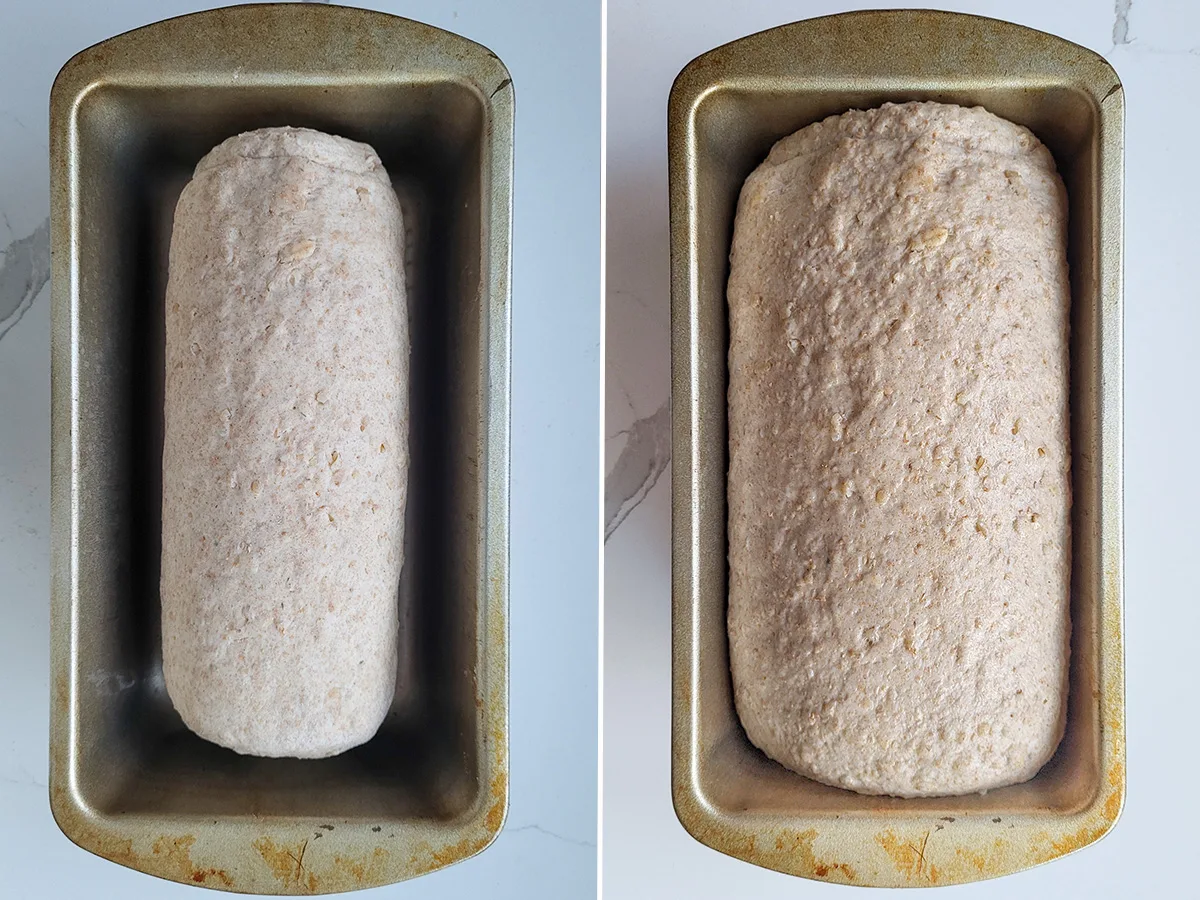
- In the morning, the dough should have risen again.
- Turn the dough out of the bowl. Pat the dough into a rectangle and roll from the short end to form a tight log.
- Set the dough into a lightly oiled loaf pan. Cover and set aside to rise for approximately 1 1/2- 2 hours.
- The risen loaf should fill up the pan. When the dough is poked it should slowly spring back.
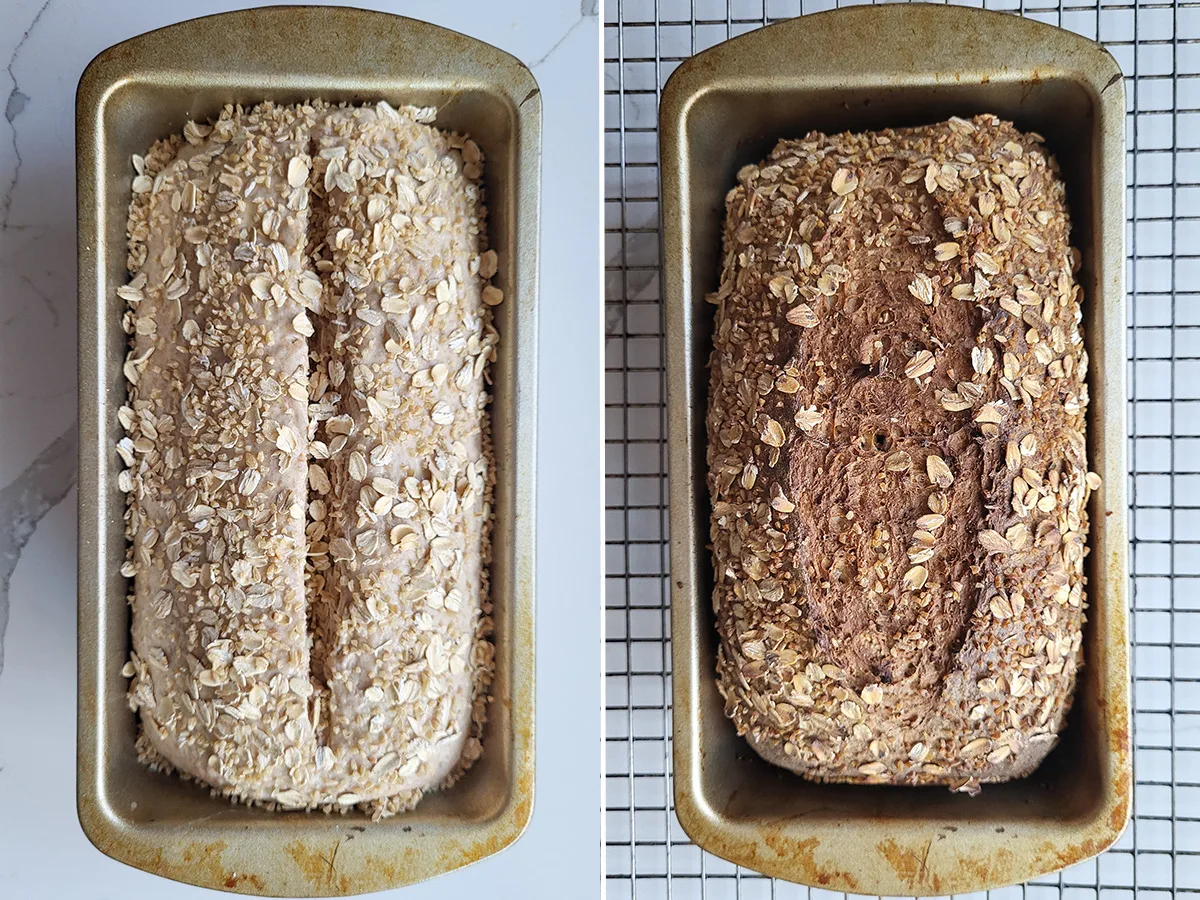
- Brush the dough with egg wash. Cut a slash down the center and sprinkle with oats and bulgur wheat.
- Bake until the interior temperature is 200F.
Pastry Chef tips for making Sourdough Multigrain Bread
- Make sure the water for soaking the wheat is at a full boil. If the water is not hot enough it won’t soften the grains.
- The whey in milk can inhibit gluten formation in bread dough. Scalding the milk denatures (breaks down) the whey protein.
- If measuring the flour by volume use the “dip & sweep” method. That is, dip the measuring cup into the flour bin, overfill it, then sweep away the excess.
- The dough will seem very sticky and you might be tempted to add more flour. Adding too much flour will make a dense loaf. After you remove the dough from the mixer it will knead together easily with a sprinkling of flour.
- After the initial fermentation, instead of refrigerating the dough overnight you can go ahead and shape, rise and bake the dough. The second rise time may be shorter if the dough is not cold from the refrigerator.
- I like to use a mixture of rolled oats and bulgur wheat for topping the bread. You can also sprinkle with sesame seeds or wheat bran.
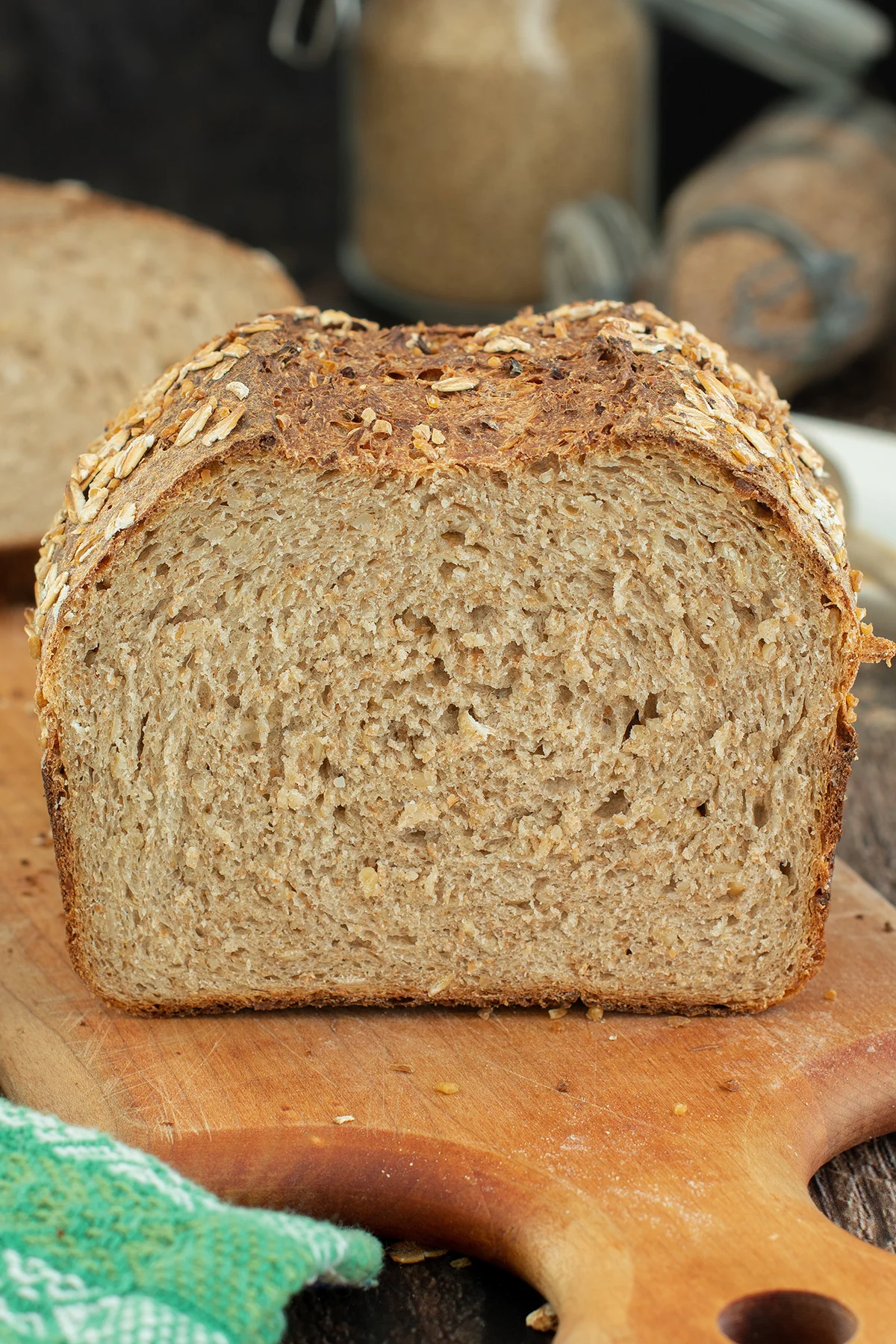
More recipes to try:
- Basic Sourdough Bread
- Sourdough Baguette
- Sourdough Soft Sandwich Bread
- Sourdough Rye Bread
- Sourdough Whole Wheat Bread
- Sourdough Cracked Wheat Bread
- Sourdough Pretzel Rolls
- Sourdough Potato Buns
- Sourdough Hoagie Rolls
- Sourdough Brioche
- Sourdough Semolina Bread
If you love this recipe as much as I do, I’d really appreciate a star rating and a quick comment. Ratings and comments help my recipes show in search results. Thanks!
Sourdough Multigrain Bread Recipe
Ingredients
- 6 ounces boiling water (¾ cup)
- 1 ½ ounces bulgur wheat (¼ cup)
- 6 ounces whole milk (¾ cup)
- 8 ounces active sourdough starter (100% hydration)
- 5 ounces bread flour (1 cup, see note)
- 1 ½ ounces honey (2 tablespoons)
- 1 ½ teaspoons table salt
- 1 ½ ounces old fashioned oats (½ cup)
- 2 ½ ounce rye flour (½ cup)
- 1 ounce wheat bran (½ cup)
- 5 ounces whole wheat flour (1 cup)
- 1 egg for egg wash
Instructions
- Combine the bulgur wheat and boiling water and set aside until cooled to about 100 °F and most of the water has been absorbed. Warm the milk until scalding hot then set it aside to cool until it is slightly warmer than body temperature.6 ounces boiling water, 1 ½ ounces bulgur wheat, 6 ounces whole milk
- In the bowl of a stand mixer or in a large mixing bowl combine the sourdough starter, soaked bulgur, milk, and the bread flour to form a smooth batter. Add the honey and salt. Stir to combine. Add the oats, bran and rye flour and stir until the batter looks like thick pancake batter. If using a stand mixer, switch to the dough hook.8 ounces active sourdough starter, 5 ounces bread flour, 1 ½ ounces honey, 1 ½ teaspoons table salt, 1 ½ ounces old fashioned oats, 2 ½ ounce rye flour, 1 ounce wheat bran
- With the mixer running, add the whole wheat flour until the dough comes together. The dough will be quite sticky and will not clear the sides of the bowl as you knead. Knead the dough for 4-5 minutes. If mixing by hand, add as much of the flour as you can in the bowl then finish kneading in the rest of the flour by hand. Dump the dough onto a lightly floured surface. Knead to form a smooth ball.5 ounces whole wheat flour
- Transfer the dough to a lightly oiled bowl, turning once to coat the dough. Cover the bowl and set it aside at room temperature for about 3 hours. Ever hour uncover the bowl, lift one side of the dough over into the middle of the dough. Repeat with the other three sides of the dough then flip the dough over. Cover the bowl. After 3 hours the dough should be lively, elastic and airy. If the dough is still sluggish give it another hour or two at room temperature.
- If you want to finish making the bread in the morning return the dough to the bowl, cover tightly and refrigerate overnight. The next morning continue with shaping. Otherwise continue shaping the loaf on the same day.
- Turn the dough out onto a floured surface. Flatten the dough to a 9" rectangle. Tightly roll the dough from top to bottom to form a log shape.
- Grease a 9"x 5" loaf pan with a very light film of vegetable oil or with baking spray. Set the dough into the pan, seam side down, and cover with oiled plastic wrap. Set in a warm place and rise until the dough almost doubles in size, about 1 ½ hours. It will take longer to rise if the dough is cold from a night in the refrigerator. In the meantime, preheat the oven to 350 °F
- Use a sharp knife or razor to cut a ½" deep slash down the center of the loaf. Brush the dough with egg wash and sprinkle with oats, bulgur and/or wheat bran.1 egg for egg wash
- Bake about 35-40 minutes until golden brown and the interior temp is 200 °F.
- Cool in the pan about 5 minutes before turning out onto a cooling rack. Cool to room temperature before slicing.
Would you like to save this recipe?
As an Amazon Associate and member of other affiliate programs, I earn from qualifying purchases.

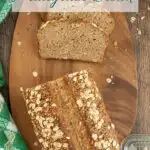
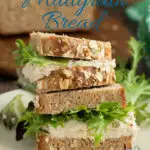
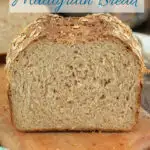
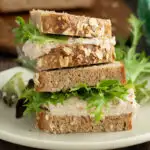





I already have a starter going but not one made with whole grains. Can I use it in this recipe? Or can I convert my existing starter to a whole grain starter?
Yes, you can use it. My starter is made with white flour and I use it for this recipe. But you can also feed your starter with a whole grain before making this bread. I’ll do that sometimes when I’m making rye bread.
This bread is delicious. It’s not easy to find breads like this in a store so I will keep this recipe in rotation. I mixed and folded in the evening and put it in the refrigerator overnight. Once I formed the loaf in the morning, I found that I needed to extend the rise time several hours in a proofing box. But, that made it easy for me to run errands and bake in the afternoon. It didn’t rise high but it did expand with nice results. Thank you for a delicious and healthy recipe!
I made this recipe, my husband picked up the loaf and commented on how heavy it was. However, he likes it toasted with honey.
Can I substitute oat bran for the wheat bran?
Yes, it is a hearty loaf. Sure, you can use oat bran.
I just want to confirm that step #6 and #8 are accurate. To me, something seems amiss… put the dough in the pan, rise, preheat oven. Then remove from pan, roll and put BACK in pan, rise another hour while the oven is still running at 350? This is my third time making this recipe (yep, we like it, even tho it’s denser than the photo it’s still great toast!) but I question those steps every time, so would love to just check! I have not been doing two rises in the bread pan, and def am not letting the oven run during the second, LOL!
Yikes, obviously I messed up the steps. I’ll fix it. Thanks for the heads up.
I just made this recipe for the first time. As someone else mentioned it was very heavy and dense. It did not raise as much as I think it should have in the pan. Fortunately the taste was good. I’m thinking my starter is the problem and I’m thinking of making a new starter. This one has been around for a few years. Any ideas to make it better? I noticed that you recommended cracked wheat instead of Bulghur to someone who could not find any Bulghur. I have been making a cracked wheat bread for a few years for my husband (not sour dough) and I no longer can find cracked wheat anywhere so I’ve been using Steel Cut Oats with good results.
The condition of your starter could make a big difference in the loaf. You want a well-fed active starter for the best results. I like to use my starter when it’s been fed and is just below it’s peak rise. Did you use steel cut oats in this bread or bulghur wheat? I do intend to test this recipe with steel cuts oats as an option but haven’t tried it yet. Any changes to the recipe could make a difference in the result. I found that the sourdough version of this bread was even lighter than the yeasted version. It certainly isn’t a “light and fluffy” bread, but it shouldn’t be extremely dense and heavy. If you under-rise or over-rise the dough it could bake up heavier. Rise the dough just until it springs back slowly when lightly pressed.
Made this twice and tastes really good, but the dough is very dry. 2nd time I added more water to recipe and was bit better but still resulted in a very heavy loaf. Any advice please ?
I made this recipe at least 6 times and got a quite sticky dough each time. Is your stater at 100% hydration? Do you weigh your ingredients or use volume measure?
@Eileen Gray, starter is at 100% hydration, I did convert the US measurements to metric as in the UK, but all the other sourdough recipes have been fine.
When I get to the stage of adding wholemeal flour the dough is so heavy the kitchen aid mixer can not cope.
Did you use the button to convert to metric? If you are in the UK I imagine that your flour or other dry ingredients could be a bit different than what we have in the US. The dough is very heavy but mine is quite sticky rather than dry.
@Lesley Ross, yes I used the button
Great. I would guess that some of the dry ingredients may vary from our US ingredients. Maybe try reducing the bread flour a little bit and see if the dough is less dry. If you see the the photos, my dough sticks to the sides of the bowl because it’s quite sticky.
@Lesley Ross, thanks – will give it a go
I can’t find bulgur wheat what can I use instead?
Cracked wheat is a good substitute.
Can anything else be substituted for the wheat bran?
Yes, you can use wheat germ or use more whole wheat flour.